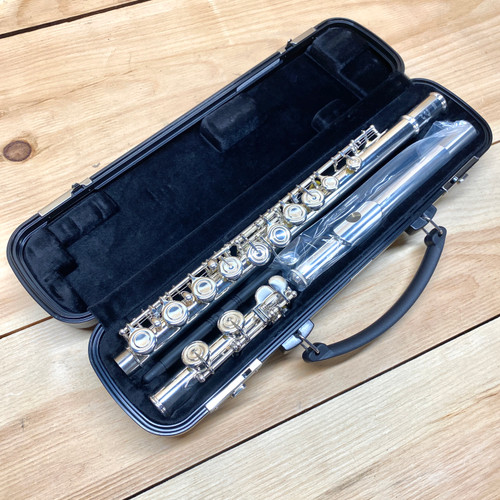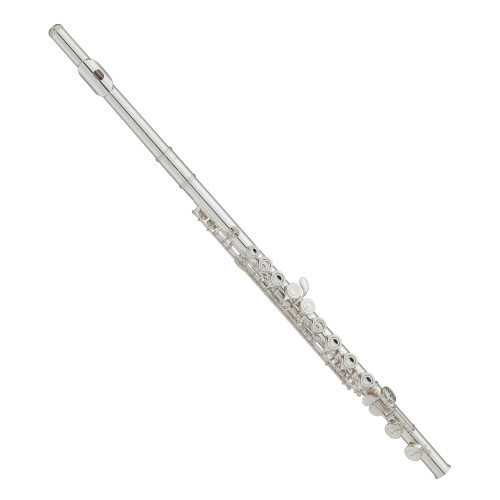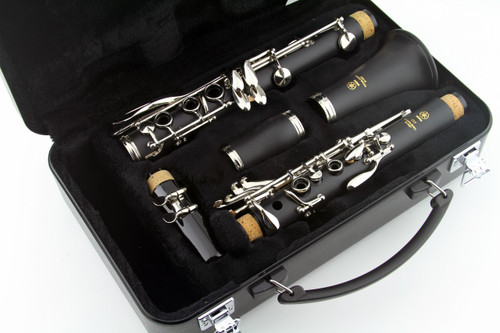Not sure which student flute is right for you? Check out Hyson Music’s Student Flute Buying Guide.
All Certified Pre-Owned Yamaha band instruments come with a 5-Year Hyson Music Warranty!
Are you in the market for the perfect entry-level flute?
The Yamaha YFL-221 has everything you could ask for in a student instrument!
The YFL-221 flute is a favorite among music educators and student musicians alike. Renowned for its ease of playability and open sound, the Yamaha Flute YFL-221 is an excellent choice for any student level musician!
Included Accessories: plastic case with handle, cleaning rod, owner's manual, polishing cloth
Yamaha’s 200 Series flute models are some of the most popular instruments available today. If you are looking for an open hole flute, consider the rest of Yamaha’s 200 series: Yamaha Flute YFL-261 (featuring an open hole offset G configuration), and Yamaha Flute YFL-281 (featuring an open hole inline G configuration).
Check out the intermediate model: Yamaha Flute YFL-361H
Yamaha YFL-221 Flute Details
Level: Standard
A standard flute is an entry-level instrument and has a three-octave range.
[Back to top]
Key: C
The standard C flute is a non-transposing instrument. Non-transposing instruments are those which are notated in the same key on paper that they sound when they are performed.
[Back to top]
Body Material: Silver plated nickel
The base metal of the YFL-221 is plated with silver. Most student flutes are plated with either nickel or silver. In terms of sound quality, there is not a difference. The primary difference lies in how these metals endure in terms of the appearance of the finish over time. Nickel plating tends to take on a cloudy appearance over time, and this cloudiness cannot be polished out. Silver plating, on the other hand, can be polished to maintain its shiny appearance. Keep in mind that silver does tarnish, and therefore maintenance with a silver polishing cloth is important. Even tarnished silver can be made to look very nice with proper polishing. Do not use liquid silver polish, as it can interfere with the mechanisms of the flute.
[Back to top]
Headjoint: CY cut; Silver plated nickel
CY refers to the cut and taper of the headjoint, factors that impact a flute’s playability in terms of affects, attack, response, timbre, tonal depth, and resistance. Yamaha’s C Cut has a large undercut to promote smooth breath flow and ideal breath speed, aiding in a strong sound presence as well as a solid low range. The Y Taper, Yamaha’s original French-style 2-stage taper, provides for excellent midrange and high-note projection, a warm timbre, and easy tonal control. Yamaha produces headjoints in a variety of cuts and tapers; the components of the YFL-221’s CY style are considered ideally suited for entry-level student musicians through intermediate level players.
[Back to top]
Key Material: Silver plated nickel
Yamaha prides itself on using only top quality, durable materials for their keys. This dedication to high standards gives the YFL-221 durable keys that are less susceptible to breakage. Some companies have been criticized for cutting corners by using softer metals for their keys, but in the end this can lead to bending and less precise mechanisms. Use of durable metal in key construction helps to prevent leaks, intonation issues, frequent repairs, and endless frustration. Key posts have been thickened and redesigned for improved durability and strength to maintain accurate rod alignment. All key shapes and placements have been ergonomically designed for comfortable, natural-feeling performance. The keys are hand-assembled and adjusted for a perfect 'touch' and balance. Double bladder pads allow for a longer life and maximum seating, reducing the need for frequent pad replacements as compared to flutes with single bladder pads.
[Back to top]
Footjoint: C
The YFL-221 has a C footjoint, the standard for all student flutes, as well as some intermediate models. There are two main types of flute footjoints: C and B. The C footjoint has the Eb key, the C# key, and the C key. The B footjoint, used for most intermediate and professional flutes, has an extra key on the end that extends the flute’s range down by a half step; a B foot aids with sound production in the lower register and intonation in the third register. It is generally recommended that students use a C footed flute footjoint for the first 3-5 years on the instrument. C foot joints are not as heavy as B foots (as the B foot adds length and the weight for an additional key). Many experts and educators feel that the extra weight can actually be a hindrance to good hand positioning, thus creating bad habits that can be difficult to break. A unique footjoint alignment mark facilitates proper fitting by young players.
[Back to top]
Tone Holes: Drawn
Flute tone holes are either drawn or soldered. The standard for student and many intermediate flutes is for the tone holes to be drawn, meaning that they are literally extracted from the metal tubing during the manufacturing process. When this method is used, no extra weight is added to the flute. When the tone holes are soldered on, additional metal is being used, as the tone hole rings are created from a separate piece of metal, and therefore the instrument will be slightly heavier. Generally, soldered tone holed instruments will be slightly more expensive because of the additional material and time needed to use this method. However, it should be noted that the additional cost associated with soldered versus drawn tone holes does not necessarily mean that the instrument’s sound quality or playability is improved. It is really a matter of preference for some professional players to use soldered tone holes; there are numerous professional model flutes that have drawn tone holes. A flute with drawn tone holes has a lighter feel and creates a lighter sound as compared to a flute with soldered tone holes, whose extra weight gives the flute a darker sound and a feeling of more resistance. The path of least resistance is decidedly the way to go for the beginning flautist.
[Back to top]
Key System: Offset G
The offset G key configuration is the industry standard for student flutes, as well as the preferred configuration for many intermediate and even professional models. An offset G key means that the G keys are slightly offset from the rest of the keys and are mounted on separate posts. This contrasts with the alternative, an inline G key, wherein the G keys are in a straight line with the rest of the flute’s keys. The offset G key can be advantageous, particularly for younger players, because it can accommodate smaller hands and tends to encourage a more comfortable hand position. Acoustically, there is not a difference between an inline G key and an offset G key.
[Back to top]
Key Types: Plateau
The YFL-221 has plateau keys, meaning that the flute does not have venting holes at the center of its keys. Plateau keys are generally recommended for beginner flautists because they are simply easier to play. The student does not have to completely cover an open hole to seal the key; logically, covering an open hole is especially difficult for young students with small fingers. As a player progresses to the intermediate level, it may be time to consider stepping up to a flute with French keys, also called an open hole flute.
[Back to top]
Spring Type: Stainless steel
Needle stainless steel springs are durable, they have strong holding power, and they do not rust. Stainless steel is the most common material used for student flute springs. The spring helps to open and close each key over the corresponding tone hole. This is an important job for a small pin; if the springs are too tight, the key will require too much pressure to close; and if the springs are too loose, keys will be slow to rise back up after being pressed.
[Back to top]
Screw Type: Straight; Headed pivot
Standard flute pivot screws come in three varieties: headed conical, non-headed conical, and headed straight (also known as headed cylindrical). The YFL-221, like most standard and many intermediate flute models, uses headed straight screws. More expensive professional models often use headed cylindrical pivot screws (also known as tapered pivot screws), which are generally agreed upon to be the best of the three types because they have the most precise fit and durability. However, for players at the beginner level in particular, this degree of precision is of negligible significance, and the straight headed pivot screw is completely adequate. Yamaha's unique screw resistance inserts allow smooth adjustments while preventing gradual loosening of the screws.
[Back to top]
Bumper Type: Neoprene
Flute bumpers are put onto the underside of keys that aren’t directly above a tone hole (such as the Eb pinky key on the foot joint). They are generally made of cork or rubber. The YFL-221 has neoprene (synthetic rubber) bumpers. While cork is more traditional, neoprene is more durable, in part because by nature cork is more easily subject to compression that neoprene. Neoprene bumpers are less susceptible to damage from moisture. With these advantages in mind, it certainly makes sense to choose a student flute with neoprene bumpers. Some advanced players prefer flutes with cork bumpers because mechanical noise is less with cork than rubber bumpers; this makes sense considering that neoprene is harder than cork. The purpose of a bumper is to prevent bending, scratching, and excess noise.
[Back to top]














